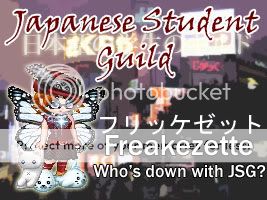for the index, click here
for the previous lesson, click here
Today's lesson: Sentance Structure and particles
The first major hump in learning Japanese for the English speaker is, in my opinion, wrapping your head around the sentance structure. In English the basic sentance structure is subject - verb - object.
I drink coffee
In Japanese the basic order is subject - object - verb. So "I drink coffee" would be
watashi wa koohii o nomimasu
わたしはコーヒーをのみます。
watashi is "Me, I," koohii is a loanword for coffee, and nomimasu is the verb for "to drink" (the polite form). So the direct English would be "I coffee drink."In Japanese, the verb is always at the end of the sentance This is a pretty solid rule, not counting question markers or emphasis markers.
Japanese has these fun little things call "particles." Ah, how to explain what the particle is? Usually they serve as a "marker" function. They mark if a certain word is a subject, an object, a time, a place, etc. In the sentance above we have 2 particles, "wa" and "o"
wa は In English terms, wa marks the subject of a sentance. Iin hiragana, wa is written with the syllabary for ha は. (wa and ga are often confused and it would take too long to get into now)
o を marks the direct object, in this case, coffee. (o has a special character,を sometimes refered to a "wo." It's different than the syllabary "o" お)
There are a lot of particles serving a lot of different functions (and it can get complicated) but in addition to "wa" and "o." here are the basic particles a beginner should know.
no の possessional marker. Basically the equivalent of "aposthropy s," use it to mark an object that specifically belongs to someone, it's also like "of," like saying if you work somewhere, you're Joe of Starbucks, or something.
watashi wa haha no koohii o nomimasu.
わたしはははのコーヒーをのみます。
I drink my mother's coffee
Honda no Yamaguchi desu.
ほんだのやまぐちです。
(I am) Yamaguchi of Honda.
watashi wa daigaku no ichi nen sei desu.
わたしはだいがくのいちねんせいです。
I am a first year student at University.
e へ this particle is pretty much attached to the verb "to go" (iku/ikimasu). It's written the same as the particle "he"へ, not as "e"え
mainichi, gakkou e ikimasu.
まいにち、がっこうへいきます。
Everyday, I go to school
ni に sadly, ni is a confusing particle because it's used for a lot of different things, but for right now, I'll just say "ni" marks a specific time, place, and is also used for the verbs "to come" and "to return."
watashi wa toshokan ni benkyou shimasu
わたしはとしょかんにべんきょうします。
I study at the library.
hachi-ji ni, watashi wa okimasu
はちじに、わたしはおきます。
At 8 o'clock , I wake up.
watashi wa toshokan ni kimasu
わたしはとしょかんにきます。
I come to the library
watashi wa uchi ni kaerimasu
わたしはうちにかえります。
I return to my home
*note: "ni" only marks specific times, not general times like today(kyou) yesterday(ashita), or everyday(mainichi)
ga が this is another particle that has several functions as you learn, but for right now we'll call it an indirect-object marker. (technically it's a subject marker, but I don't have the energy to get into the difference between wa and ga)
watashi wa eiga ga suki desu
わたしはえいががすきです。
I like movies.
watashi wa inu ga imasu
わたしはいぬがいます。
I have a dog
I know this stuff stinks, but it's that necessary crap that you need to know.
*note* I used "watashi wa" for the benefit of true beginners of Japanese, but in reality, you could omit "watashi wa" in all the previous sentances and still have an understandable statement. I'll explain the differences between the English use of pronouns and Japanese use of pronouns later.
for the next lesson, click here
View User's Journal
Freakezette's Freaki Journal
The best place for gaia Japanese lessons, and updates on me, because I know you care.
|
Freakezette
Community Member |


